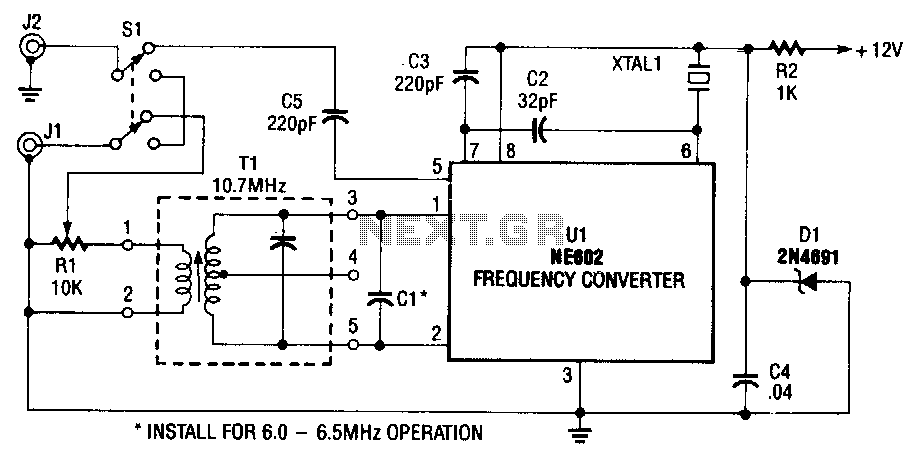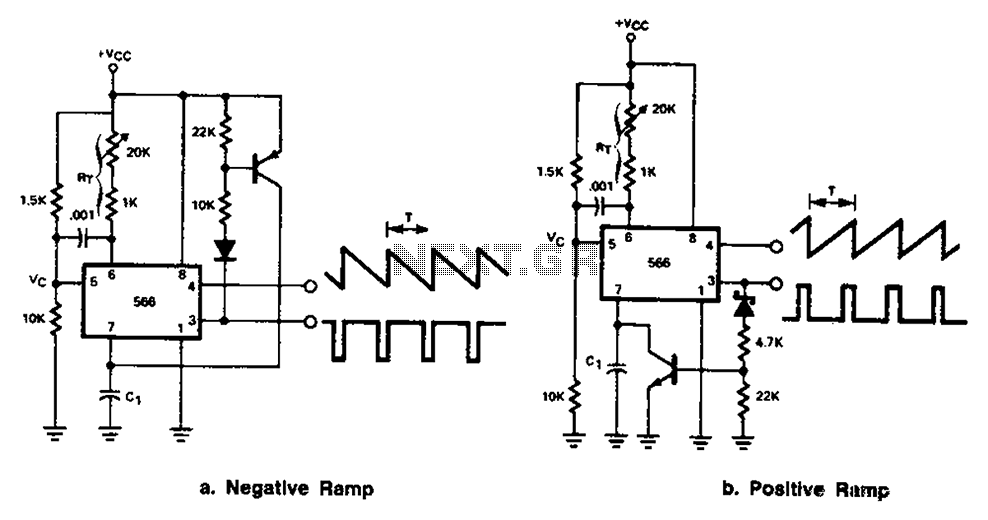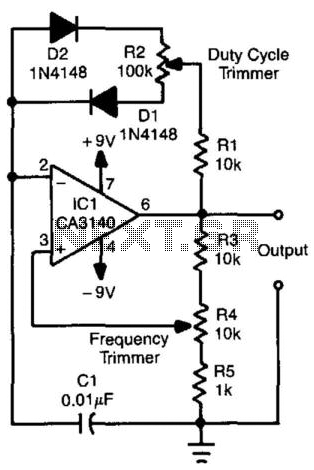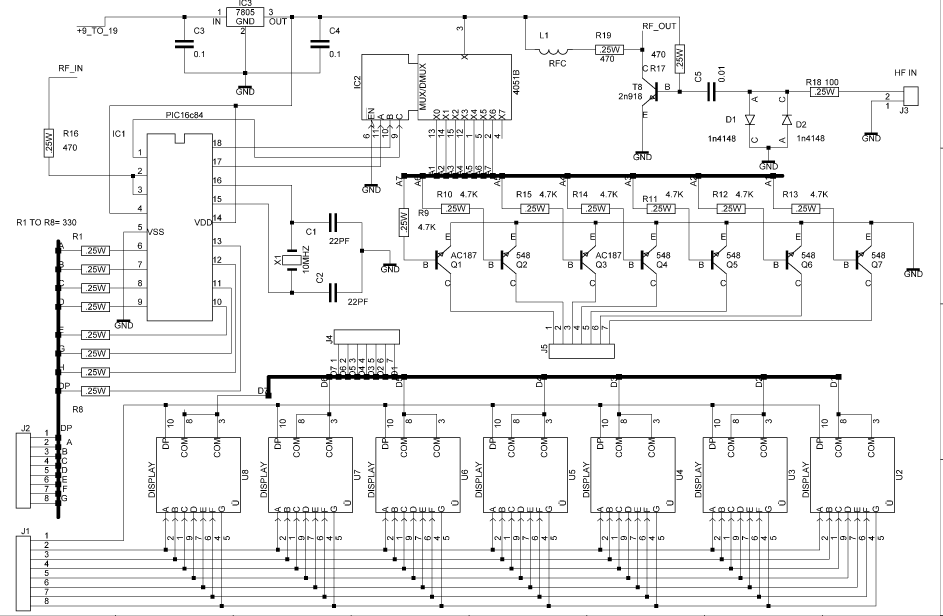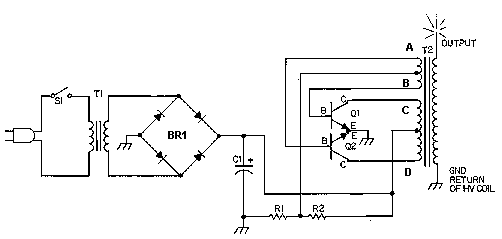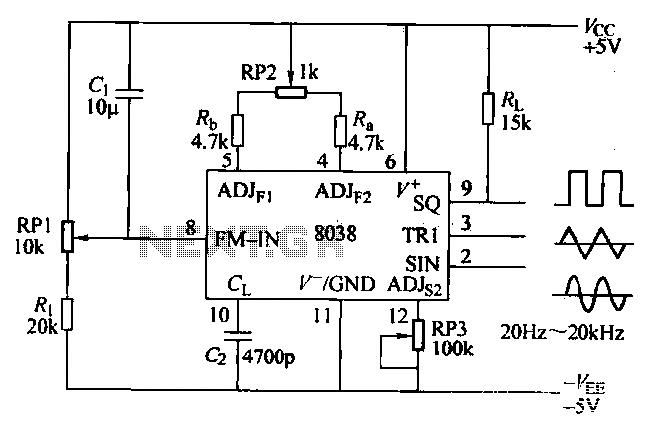
Adjustable High/Low Frequency Sine wave generator
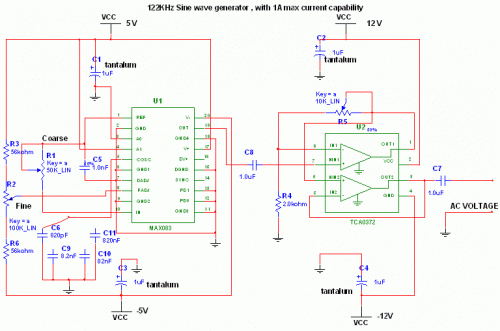
This circuit utilizes the versatile MAX038 function generator. While some advanced features of this IC are disabled in this configuration, it can still generate sine, triangle, and square waves by adjusting the A0 and A1 pins (refer to the datasheet for additional waveforms with a switch). The selected frequency of 122 kHz is chosen for a low-cost ESR meter to monitor the health of electrolytic capacitors, which need to discharge tens of amperes in less than 2 ms. At 122 kHz, capacitive reactance is minimal, and inductive reactance is not significant, allowing for a current (e.g., 200 mA, using a precision resistor) to flow through a capacitor while measuring the AC voltage drop across it to estimate the ESR (voltage drop/current). Although inductive and capacitive reactance are still present, they are negligible. The 122 kHz, 2V peak-to-peak sine wave is generated by the MAX038 IC, with frequency calculated using the formula Freq (MHz) = Iin(uA) / C6 (pF). Here, Iin = 2.5V / R1 (25 kΩ default), resulting in a frequency of 0.122 MHz. The resistor allows for minor adjustments; it is advised not to go below 10 kΩ or above 40 kΩ to maintain accuracy. For multi-frequency options, a multiposition switch can be used with capacitors of 820 pF, 8.2 nF, 82 nF, and 820 nF for the 122 kHz range, as well as for 12.2 kHz, 1220 Hz, and 122 Hz ranges. Fine-tuning can be achieved by adjusting R2, allowing the frequency to vary from 1.7x (Vfadj = -2.4) to 0.3x (Vfadj = 2.4) of the main frequency when fadj is at 0V. The sine wave output is fed into a TCA0372 half op-amp to achieve a gain from 1 to 5 (2V peak-to-peak to 10V peak-to-peak), adjustable via a potentiometer, and then into a TCA0372 buffer stage also present on the same IC. Frequency adjustments require a frequency counter, so this circuit should be used in conjunction with one. The maximum current is 1A, but it is recommended not to exceed 0.5A for accuracy. The circuit requires a computer power supply providing 12V, 5V, -5V, -12V, and GND; alternatively, a multi-voltage mains transformer (15 watts is sufficient) can be used, along with low-current diode bridges (1-2 Amps), smoothing capacitors of 10,000 µF at 16V, and voltage regulators such as LM7905 and LM7912.
The MAX038 function generator is a highly integrated device capable of producing a variety of waveforms, making it suitable for applications such as this ESR meter. The circuit design leverages its capability to generate sine, triangle, and square waves, with the output frequency determined by both external resistors and capacitors. The choice of 122 kHz is particularly advantageous for measuring the equivalent series resistance (ESR) of electrolytic capacitors, as it strikes a balance between reactance and measurement accuracy.
The ESR meter operates by applying an AC signal across the capacitor under test and measuring the voltage drop, which is proportional to the ESR. The use of a precision resistor in series with the capacitor allows for accurate current measurement, facilitating the calculation of ESR through Ohm's law. The TCA0372 op-amp serves to amplify the output signal to a level suitable for further processing or display, ensuring that the measurement is both clear and precise.
To accommodate various testing scenarios, the circuit includes options for frequency adjustment through a multiposition switch, allowing for rapid changes in testing conditions without the need for extensive reconfiguration. The design emphasizes ease of use and flexibility, making it suitable for both hobbyists and professionals in electronics.
Powering the circuit with a computer power supply or a multi-voltage transformer ensures that all necessary voltage levels are available, supporting the operational requirements of the MAX038 and associated components. The inclusion of smoothing capacitors and voltage regulators further enhances the stability and reliability of the circuit, minimizing noise and fluctuations that could affect measurement accuracy.
Overall, this circuit design effectively combines functionality and versatility, providing a reliable tool for assessing the health of electrolytic capacitors in various applications.This circuit uses the versatile MAX038 function generator. Although in this circuit some of the advanced characteristics of this IC are disabled, you can generate Sine, Triangle, Square waves (adjusting A0 and A1 pins see datasheet on if you want other waves, use a switch). I selected this particular frequency (122 Khz) because i needed a cheapo ESR-o-meter for my electrolytic capacitors to monitor their health as they have to discharge tens of amperes in less than 2 ms. At 122 KHz capacitive reactance is very low, and inductive reactance isn`t so high, so forcing a current (es 200mA, using a precision resistor) through a capacitor and reading AC voltage drop accross it gives me an estimation of ESR (Vdrop/current).
Of course inductive and capacitive reactance are still present, but negligible. The 122 khz 2V p-p sine wave is generated by the MAX038 IC, its frequency can be calculated by the formula Freq (MHz) = Iin(uA) / C6 (pf). Iin = 2, 5V / R1 (25Kohm default). So the freq is 0, 122 MHz. The resistor is for small adjustments, don`t go under 10000 Kohm or above 40000 Kohm because the accuracy will drop.
If you want multifrequency just use the multiposition switch with 820 pF, 8, 2 nF, 82nF, 820 nf for 122Khz range 12, 2Khz range 1220 Hz and 122 Hz. Fine tuning can be done adjusting R2, the frequency can vary from 1, 7x (Vfadj = -2, 4) to 0, 3x (Vfadj = 2, 4) of the main frequency (when fadj is at 0V).
The sine wave output is feed into a TCA0372 1/2 opamp to achieve a gain from 1 to 5 (2V p-p, 10 V p-p), adjust the potenziometer and into a TCA0372 2/2 opamp buffer stage also present on the same IC. Adjusting the frequency needs a frequency counter, so this circuit should be used on conjunction with a freq couter.
The max current is 1A, but i would suggesto to not go above 0, 5A to remain accurate. Needs a computer power supply with 12V, 5V, -5V, -12V, GND to be operated, if you don`t have one just use a multivoltage mains transformer (15 watt is enough) diode bridges (low current 1-2 Amps), smoothing capacitors 10000uF 16V, and voltage regulators such as LM7905 and LM7912. We aim to transmit more information by carrying articles. Please send us an E-mail to wanghuali@hqew. net within 15 days if we are involved in the problems of article content, copyright or other problems.
We will delete it soon. 🔗 External reference
The MAX038 function generator is a highly integrated device capable of producing a variety of waveforms, making it suitable for applications such as this ESR meter. The circuit design leverages its capability to generate sine, triangle, and square waves, with the output frequency determined by both external resistors and capacitors. The choice of 122 kHz is particularly advantageous for measuring the equivalent series resistance (ESR) of electrolytic capacitors, as it strikes a balance between reactance and measurement accuracy.
The ESR meter operates by applying an AC signal across the capacitor under test and measuring the voltage drop, which is proportional to the ESR. The use of a precision resistor in series with the capacitor allows for accurate current measurement, facilitating the calculation of ESR through Ohm's law. The TCA0372 op-amp serves to amplify the output signal to a level suitable for further processing or display, ensuring that the measurement is both clear and precise.
To accommodate various testing scenarios, the circuit includes options for frequency adjustment through a multiposition switch, allowing for rapid changes in testing conditions without the need for extensive reconfiguration. The design emphasizes ease of use and flexibility, making it suitable for both hobbyists and professionals in electronics.
Powering the circuit with a computer power supply or a multi-voltage transformer ensures that all necessary voltage levels are available, supporting the operational requirements of the MAX038 and associated components. The inclusion of smoothing capacitors and voltage regulators further enhances the stability and reliability of the circuit, minimizing noise and fluctuations that could affect measurement accuracy.
Overall, this circuit design effectively combines functionality and versatility, providing a reliable tool for assessing the health of electrolytic capacitors in various applications.This circuit uses the versatile MAX038 function generator. Although in this circuit some of the advanced characteristics of this IC are disabled, you can generate Sine, Triangle, Square waves (adjusting A0 and A1 pins see datasheet on if you want other waves, use a switch). I selected this particular frequency (122 Khz) because i needed a cheapo ESR-o-meter for my electrolytic capacitors to monitor their health as they have to discharge tens of amperes in less than 2 ms. At 122 KHz capacitive reactance is very low, and inductive reactance isn`t so high, so forcing a current (es 200mA, using a precision resistor) through a capacitor and reading AC voltage drop accross it gives me an estimation of ESR (Vdrop/current).
Of course inductive and capacitive reactance are still present, but negligible. The 122 khz 2V p-p sine wave is generated by the MAX038 IC, its frequency can be calculated by the formula Freq (MHz) = Iin(uA) / C6 (pf). Iin = 2, 5V / R1 (25Kohm default). So the freq is 0, 122 MHz. The resistor is for small adjustments, don`t go under 10000 Kohm or above 40000 Kohm because the accuracy will drop.
If you want multifrequency just use the multiposition switch with 820 pF, 8, 2 nF, 82nF, 820 nf for 122Khz range 12, 2Khz range 1220 Hz and 122 Hz. Fine tuning can be done adjusting R2, the frequency can vary from 1, 7x (Vfadj = -2, 4) to 0, 3x (Vfadj = 2, 4) of the main frequency (when fadj is at 0V).
The sine wave output is feed into a TCA0372 1/2 opamp to achieve a gain from 1 to 5 (2V p-p, 10 V p-p), adjust the potenziometer and into a TCA0372 2/2 opamp buffer stage also present on the same IC. Adjusting the frequency needs a frequency counter, so this circuit should be used on conjunction with a freq couter.
The max current is 1A, but i would suggesto to not go above 0, 5A to remain accurate. Needs a computer power supply with 12V, 5V, -5V, -12V, GND to be operated, if you don`t have one just use a multivoltage mains transformer (15 watt is enough) diode bridges (low current 1-2 Amps), smoothing capacitors 10000uF 16V, and voltage regulators such as LM7905 and LM7912. We aim to transmit more information by carrying articles. Please send us an E-mail to wanghuali@hqew. net within 15 days if we are involved in the problems of article content, copyright or other problems.
We will delete it soon. 🔗 External reference
Warning: include(partials/cookie-banner.php): Failed to open stream: Permission denied in /var/www/html/nextgr/view-circuit.php on line 713
Warning: include(): Failed opening 'partials/cookie-banner.php' for inclusion (include_path='.:/usr/share/php') in /var/www/html/nextgr/view-circuit.php on line 713
